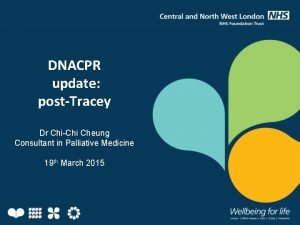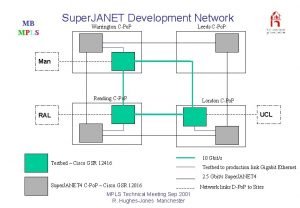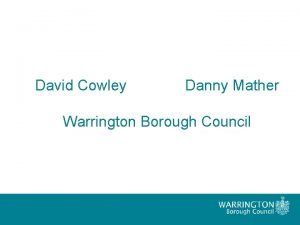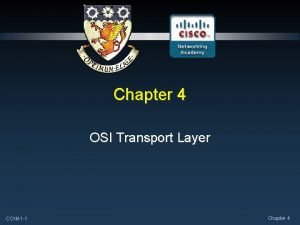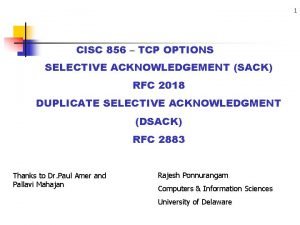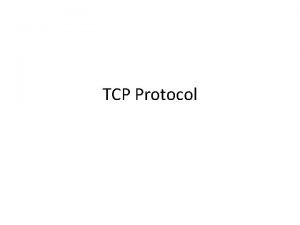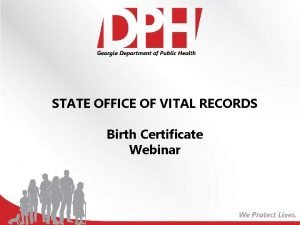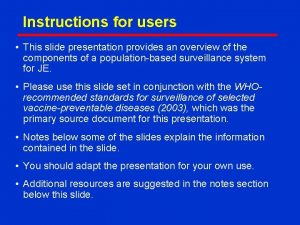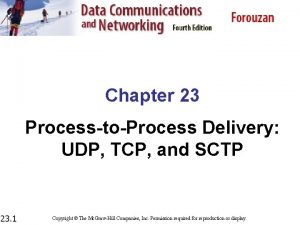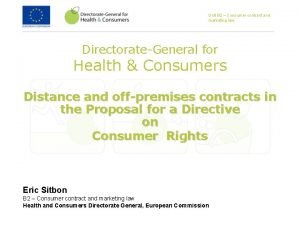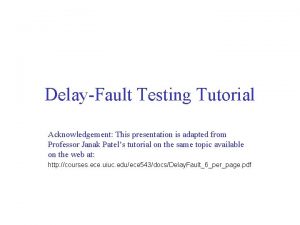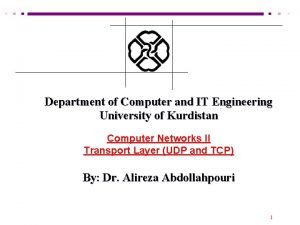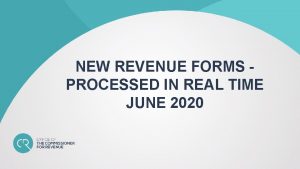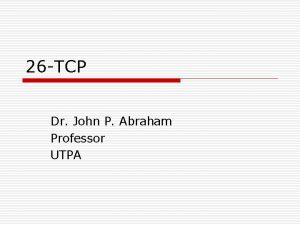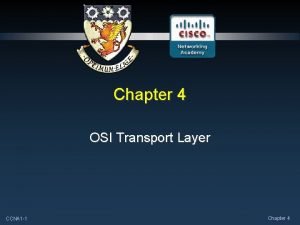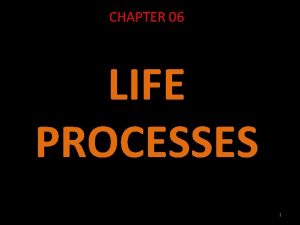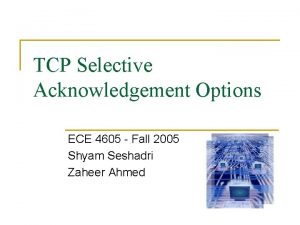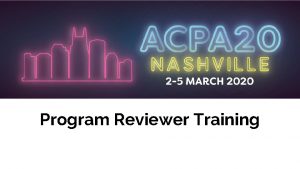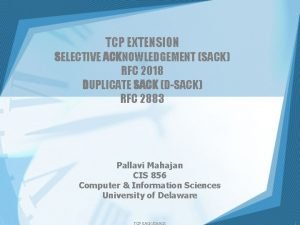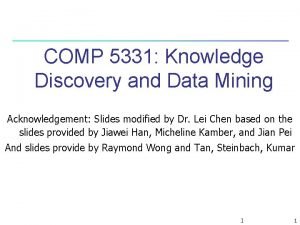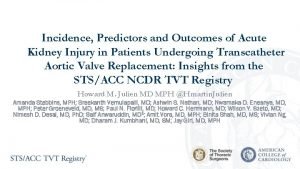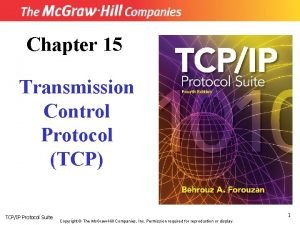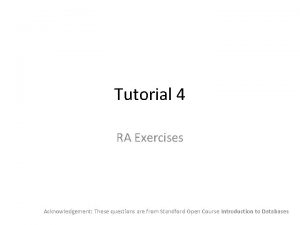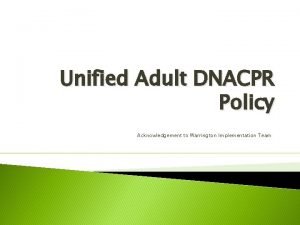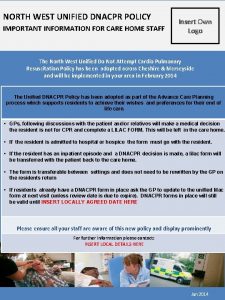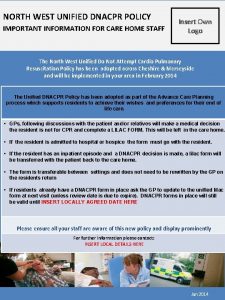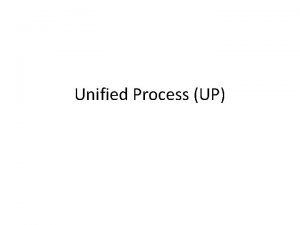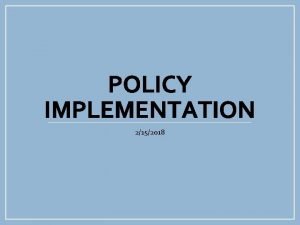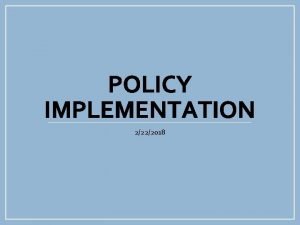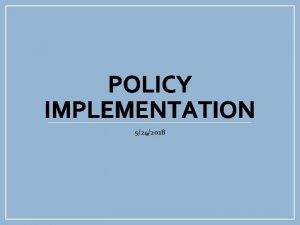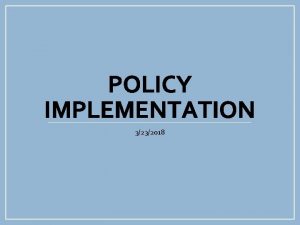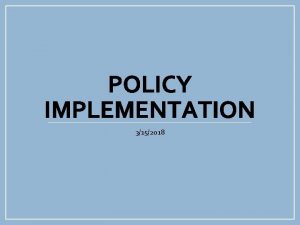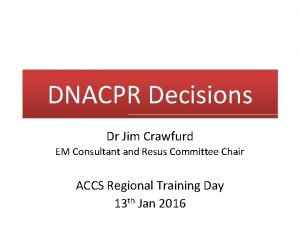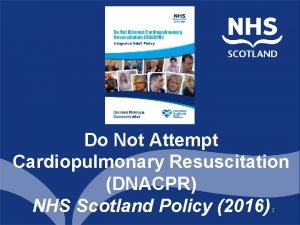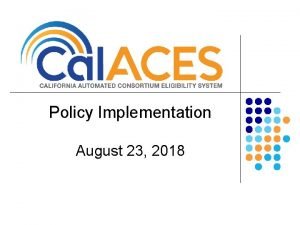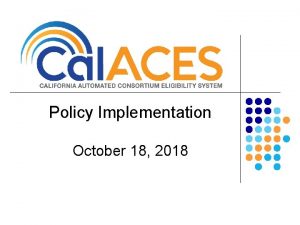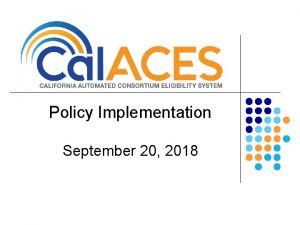Unified Adult DNACPR Policy Acknowledgement to Warrington Implementation






































- Slides: 38

Unified Adult DNACPR Policy Acknowledgement to Warrington Implementation Team

Then � Defibrillation (attempting to re-set the heart rhythm with a DC electrical shock) was first used to re-start a human heart in 1947. � Alongside other elements of CPR, it has been a standard part of coronary care and cardiac surgical practice since the 1960 s. � Initially patients were selected to have this new treatment

Now � The default position is to attempt CPR in the event of a cardiac arrest unless there is an advance decision not to.

UK Resuscitation Council Guidance � � The revised guidance was published in 2014 Survival from CPR is relatively low: ◦ Chances of survival to hospital discharge is 1520% ◦ Chances in out of hospital arrest is 5 -10% � � Post arrest most patients will require HDU/ITU/CCU CPR is not risk free

UK Resuscitation Council Guidance � There is no legal/ethical requirement to discuss every eventuality with patients if risk of cardiac arrest is low � If there is an identifiable risk of arrest it is desirable to make decisions regarding CPR � Making decisions early is preferable to making them in a crisis situation

Non-Discrimination � � Decisions should be tailored to individual circumstances of patient ‘Blanket policies to deny CPR to whole groups are unethical and probably unlawful’ Decisions must be made objectively If there is no explicit decision about CPR the presumption should be to perform CPR in the event of a cardiac arrest Decisions relating to CPR UK Resuscitation Council 2014

DNACPR Decisions � � Where the team is as sure as it can be that CPR would be unlikely to restart the heart and breathing, CPR should not be offered. A DNACPR in itself is not legally binding and may be overridden by professionals if circumstances of a cardio respiratory arrest do not match the circumstances envisaged when making the initial DNACPR order e. g. in patients with a DNACPR order, it may be appropriate to suspend that decision temporarily e. g. ◦ Blocked tracheostomy ◦ During certain procedures � Need to discuss with patient so they are aware that the decision can be suspended in these situations Decisions relating to CPR UK Resuscitation Council 2014

Communicating DNACPR decision to patients � � � There should be a presumption in favour of informing the patient of a DNACPR decision There needs to be convincing reasons not to inform the patient i. e. where the clinician considers that to do so is likely to cause the patient physical or psychological harm There should be clear and accurate communication with the patient and those close to the patient unless the patient has requested confidentiality Decisions relating to CPR UK Resuscitation Council 2014

Weighing up benefits and burdens � � � Where CPR may result in return of spontaneous breathing and circulation but may be followed by a length and quality of life unacceptable to the patient Patient should be part of decision making process if they wish to participate in discussions Decisions should be made in the best interests of the patient ◦ ◦ � Likely outcome Patient’s human rights Likelihood of having severe pain and suffering Level of awareness patient has of their surroundings MDT discussion Decisions relating to CPR UK Resuscitation Council 2014

Where patients lack capacity � Consider any previously expressed wishes � Check whether patient has an LPA (lasting power of attorney) Discussion and agreement between the healthcare team and those close to or representing the patient (unless a patient had previously expressed a wish that information is withheld Consulting with those close to patients is not only good practice but a requirement of the Human Rights Act (Article 8) � � Communication should be done by experienced members of Decisions relating to CPR UK Resuscitation Council 2014 the team

Documentation of CPR Decisions � � � Decisions should be accessible to all health and social care professionals who may need them Any decisions relating to CPR should be communicated between healthcare professionals when patients move between settings Overall responsibility for DNAR decision rests with the most senior healthcare professional responsible for the patient’s care Decisions relating to CPR UK Resuscitation Council 2014

GMC Guidance � Published 2010 � DNACPR seen as good practice for ensuring that people who are dying have a peaceful dignified death. � Seen as part of good advance care planning

GMC Guidance � In cases in which CPR might be successful, it might still not be seen as clinically appropriate because of the likely clinical outcomes: ◦ Weigh up the benefits, burdens and risks of treatment that the patient may need if CPR is successful. ◦ In cases where you assess that such treatment is unlikely to be clinically appropriate, you may conclude that CPR should not be attempted

� ‘You must approach discussions sensitively and bear in mind that some patients, or those close to them, may have concerns that decisions not to attempt CPR might be influenced by poorly informed or unfounded assumptions about the impact of disability or advanced age on the patient’s quality of life. ’

Decisions about CPR at End of Life � Don’t make assumptions about patients’ wishes � Some patients may find discussions about this very burdensome and some may want the discussion. � You should not withhold information simply because conveying it is difficult or uncomfortable for you or the healthcare team.

� If you conclude that the patient does not wish to know about or discuss a DNACPR decision, you should seek their agreement to share with those close to them, with carers and with others, the information they may need to know in order to support the patient’s treatment and care. � If a patient lacks capacity, you should inform any legal proxy and others close to the patient about the DNACPR decision and the reasons for it.

Where CPR may be successful � � � If CPR may be successful, the benefits of prolonging life must be weighed against the potential burdens and risks. The patient should be involved in the discussion if they want to and this should be done sensitively You should explain any doubts about whether the burdens and risks of CPR would outweigh the benefits, including whether the level of recovery expected after successful CPR would be acceptable to the patient. Some patients may wish to receive CPR where there is no/little chance of success. ‘If, after discussion, you still consider that CPR would not be clinically appropriate, you are not obliged to agree to attempt it in the circumstances envisaged. ’ You should explain your reasons and any other options that may be available to the patient, including seeking a second opinion.

Patients who Lack Capacity � � � If a patient lacks capacity to make a decision about future CPR, consult any legal proxy who has authority to make the decision If there is no legal proxy, discuss the issue with those close to the patient and with the healthcare team. If they do not have legal authority to make the decision, you must not give them the impression that it is their responsibility to decide whether CPR will be of overall benefit to the patient. If the legal proxy requests that CPR with a small chance of success in spite of the burdens and risks, or they are sure that this is what the patient wanted, and it is your considered judgement that CPR would not be clinically appropriate and not of overall benefit for the patient, you should explore the reasons for the proxy’s request. If after further discussion you still consider that attempting CPR would not be of overall benefit for the patient, you are not obliged to offer to attempt CPR in the circumstances envisaged. You should explain your reasons and any other options that may be available to the legal proxy, including their right to seek a second opinion.

Treatment and Care after a DNACPR Order � Make it clear that a DNACPR decision applies only to CPR. It does not imply that other treatments will be withdrawn or withheld. � Can reverse the DNACPR in certain circumstances e. g. choking, on induction of anaesthesia

NWAS Integrated DNACPR Policy Why do we need one?

Bob � Bob was a 78 year old gentleman with metastatic bowel cancer. � His wish had been to die at home and the GP, district nurses and community palliative care nurses knew of this. � He was becoming increasingly frail and bed bound and his family were told that time was short. � One morning whilst his daughter was taking the children round the corner to school, Bob stopped breathing. � His wife had been very anxious all the way through Bob’s illness and panicked. She called 999 as she could not remember the advice given by the GP

Bob � The ambulance was there in no time at all. The paramedics had been briefed that there was a patient in respiratory arrest in the house and they started CPR and insisted on taking Bob to hospital. Bob’s daughter arrived home to see the ambulance leaving and her mum distraught on the front path. � The CPR was stopped very soon after arrival in the Emergency department as the hospital notes were accessible. � Bob’s wife and daughter got to the hospital after it was all over but had to wait for someone to come and speak with them and also for the police to come.

New Form � This decision will be regarded as “ONGOING” unless: There are changes in the person’s condition Their expressed wishes change � DNACPR decisions should be subject to ongoing monitoring to ensure they remain appropriate � it is recommended that a review date be considered and entered on the DNACPR decision form if appropriate. � It is important to note that a review date does not equate to an expiry date for ongoing decisions and remains clinically appropriate and valid. � The basis on which decision has been made and what conversations have occurred about it should be recorded Ø Ø Ø The lilac copy of the form stays with the person One white copy remains in the medical notes One white copy is retained for audit purposes

Using the Form � There are packs of the triplicate forms in all areas. � There is an electronic version of the form which must be printed on lilac paper � The lilac form travels with the patient between home/hospital/hospice � There should also be documentation in the patient’s notes that the DNACPR order has been made

Setting Specific Info � � � The lilac form is placed in their home A white copy remains in their notes at the GP’s surgery Also make a note in the records The third white copy is retained for audit purposes. There is a tear off slip for the message in a bottle scheme if this is active in your area In the patient’s home � The triplicate form stays together in the front of the person’s notes until death or discharge. On discharge (from the care setting instigating the form): ◦ The lilac copy of the form stays with the person ◦ One white copy remains in the medical notes and; ◦ One white copy is retained for audit purposes In an inpatient setting (hospital/hospice/nursing home/prison)

Cancelling the decision BG oo de (B GO O DE ) • If the decision is cancelled, the form should be crossed through with two diagonal lines in black ink and the word ‘CANCELLED’ written clearly between them, dated, signed and name printed by the health care staff. /10 25 ED CE LL CA N • It is the responsibility of the person cancelling the decision to communicate this to all parties informed of the original decision. Update form /13 • Retain the cancelled form in the person’s notes.

Making the Decision � There are several factors to be considered: ◦ Would CPR realistically have a chance of restarting the heart and breathing? ◦ Would the patient be accepted for care to CCU/ITU? ◦ Is CPR an appropriate treatment to offer? ◦ What are the patient’s wishes? ◦ Would the patient be harmed by having discussions around CPR?

For patients who lack capacity � � If the decision is a straightforward clinical one on the grounds that it would be unsuccessful then make the DNACPR decision and speak to those close to the patient If there is a chance CPR will work but there are other factors which mean a competent patient might refuse then a best interests decision should be made informed by the MDT and the views of those close to the patient about what the patient’s wishes might have been Relatives or LPAs with authority to make health and welfare decisions do not have the right to demand clinically inappropriate treatment. Where a patient has no relatives an IMCA should be contacted. This should not delay the decision however

Having the Discussion

‘Don’t ask me about resuscitation for him. They asked me that about me mother 10 years ago and I’ve felt ever since like I killed her’ ‘I’m not ready to die yet so don’t be talking to me about that’



General Principles � Start with what you are going to do not what you’re not � In the majority of cases it is ‘breaking bad news’ � Remember saying ‘to resuscitate’ implies that it can be done/will work � Do Don’t offer it as an option if there is no chance it will work. � Don’t pose it as the relatives’ decision – it is not (unless they are an LPA with authority to make health and welfare decisions. Even they can only refuse it not demand it)

When to discuss with patients � � � DNACPR decisions should be discussed with patients unless there is a risk of significant harm coming to them by having the conversation. If a person is to have a DNACPR form in their house and they are able to access their District Nursing notes they should know about the decision Avoid having the conversation on the day of discharge if a form needs to go home with the person If someone is deteriorating rapidly and likely to die imminently it may not be appropriate to have that conversation with them and will change the focus of the discussions to have with the family If a patient indicates that they do not wish to have the conversation then it should not be forced upon them

What to say � Need to emphasize what the decision means: treatment for all the reversible things we can but if it doesn’t work and the heart stops then there isn’t anything we could do to restart it � Still would get treatment in hospital if needed. � Does not have a bearing on chemotherapy etc. � � Patients/relatives need to know that they should bring the form with them to hospital/the hospice/if they are going into a respite/rehab/long term nursing care facility. They should alert visiting health professionals/paramedics to the whereabouts of the form in their home if needed.

What if they refuse? � � � No-one can demand a clinically inappropriate treatment Disagreements should hopefully be rare if the discussion is approached sensitively Always aim for consensus, case conferences, mediation etc. A second senior doctor (consultant or GP) opinion should be sought. Involvement of organisational legal department may be necessary Ultimately a patient cannot be forced to have a DNACPR form in their house if they don’t want one

Discussion

Further Reading � https: //www. resus. org. uk/pages/dnacpr. htm � www. gmc-uk. org/guidance/ethical_guidance/end_of_life_care. asp � www. adrt. nhs. uk � www. nwas. nhs. uk/health-professionals/end-of-life-care/udnacpr/ � Time to intervene? A review of patients who underwent cardiopulmonary resuscitation as a result of an in-hospital cardiopulmonary arrest National Confidential Enquiry into Patient Outcome and Death 2012
 Dnacpr osce
Dnacpr osce Mpls leased line warrington
Mpls leased line warrington Danny mather warrington
Danny mather warrington Shallice and warrington kf
Shallice and warrington kf Steps in policy making
Steps in policy making Kindratenko
Kindratenko Acknowledgement slides
Acknowledgement slides Expectational acknowledgement
Expectational acknowledgement D-sack sequence
D-sack sequence Acknowledgement special thanks to
Acknowledgement special thanks to Technical background in research example
Technical background in research example Tcp header
Tcp header Paternity acknowledgement form 3940
Paternity acknowledgement form 3940 Acknowledgement slide
Acknowledgement slide Borders for acknowledgement
Borders for acknowledgement The value of acknowledgement field in a segment defines
The value of acknowledgement field in a segment defines Consumer contract
Consumer contract Acknowledgement in presentation
Acknowledgement in presentation The value of acknowledgement field in a segment defines
The value of acknowledgement field in a segment defines Registration acknowledgement
Registration acknowledgement The value of acknowledgement field in a segment defines
The value of acknowledgement field in a segment defines Expectational acknowledgement
Expectational acknowledgement Acknowledgement for project
Acknowledgement for project Acknowledgement for project
Acknowledgement for project Acknowledgement
Acknowledgement Selective acknowledgement
Selective acknowledgement Acknowledgement
Acknowledgement Acknowledgement for ppt project
Acknowledgement for ppt project Acknowledgement process
Acknowledgement process Acpa land acknowledgement
Acpa land acknowledgement Wmo hq
Wmo hq Acknowledgement god
Acknowledgement god Acknowledgement slide
Acknowledgement slide Tnea acknowledgement receipt
Tnea acknowledgement receipt Selective acknowledgement
Selective acknowledgement Acknowledgement slide
Acknowledgement slide Acknowledgement for college project
Acknowledgement for college project The value of acknowledgement field in a segment defines
The value of acknowledgement field in a segment defines Suppose relation r(a b)
Suppose relation r(a b)
